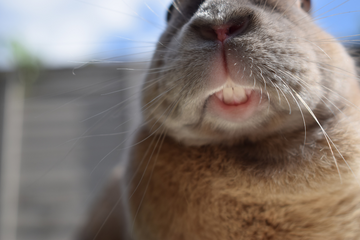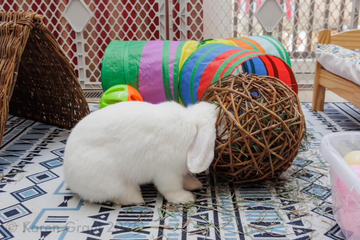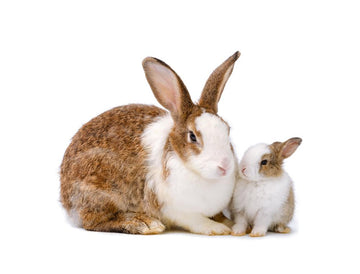Rabbits and Dogs: Can They Be Friends?
Bringing a rabbit into a home with two dogs is a big decision. While some dogs and rabbits form strong bonds, their differences in instinct and behavior can make coexistence tricky. Before introducing a rabbit to your dogs, it's essential to understand their natural instincts and take steps to create a safe, stress-free environment.
Click Here to Shop Rabbit Products.

Rabbits are prey animals, while dogs are natural predators. This contrast doesn't mean they can't live together, but it requires patience, training, and careful supervision. In this guide, we'll cover everything you need to know about keeping rabbits and dogs in the same home, including potential challenges, essential training tips, and best practices for introductions.
Understanding the Relationship Between Rabbits and Dogs
Dogs and rabbits communicate in completely different ways. Dogs use body language, vocalizations, and pack behavior to establish dominance and social order. Rabbits, on the other hand, rely on subtle movements, quiet communication, and an instinct to flee when they sense danger.
Because of these differences, misunderstandings between rabbits and dogs can happen quickly. A dog may see a rabbit's quick movement as an invitation to chase, while a rabbit may view a friendly sniff as a potential threat. Recognizing these differences is key to helping them coexist peacefully.
Key Factors to Consider Before Introducing Rabbits and Dogs
Before bringing a rabbit into a home with dogs, take time to assess your dogs' behaviors, training level, and home setup. Remember, patience, training, and supervision are key to coexistence. Here are some important factors to consider:

1. Your Dogs' Temperaments
Every dog has a different personality. Some dogs are naturally calm and gentle, while others have high energy levels and a strong prey drive. When evaluating whether your dogs can live with a rabbit, ask yourself:
Do your dogs chase small animals outside?
Do they remain calm in new situations?
Have they been exposed to small animals before? How did they react?
If your dogs tend to chase small animals or become overly excited, they will need extra training and supervision before meeting a rabbit.
2. Breed Characteristics
Some dog breeds are more prone to chasing and hunting behavior than others. While individual temperament plays a big role, breed instincts should also be considered.
High Prey Drive Breeds: Terriers, Greyhounds, and hunting breeds are more likely to chase or see a rabbit as prey.
Lower Prey Drive Breeds: Labradors, Golden Retrievers, and toy breeds tend to be more adaptable, but temperament varies by individual.
For more on understanding dog breed instincts, visit the American Kennel Club's breed information page.
3. Training and Obedience
Well-trained Dogs are more likely to respond to commands and behave appropriately around a rabbit. Make sure your dogs understand these basic commands:
"Sit" and "Stay": Helps control excitement and impulsiveness.
"Leave it": Stops dogs from chasing or bothering the rabbit.
"Come": Ensures you can call your dog away if needed.
Need help training your dog? The ASPCA offers useful dog training tips.
4. Space and Housing
Rabbits need a secure space where they can feel safe. Before bringing a rabbit home, consider:
Providing a secure enclosure or separate room.
Keeping the rabbit's space off-limits to dogs when unsupervised.
Creating a neutral area for introductions.
5. Time Commitment
Introducing rabbits and dogs takes time. Be prepared to:
Supervise interactions daily, especially at first.
Separate them when you aren’t home.
Be patient—introductions can take weeks or months.
Potential Challenges in Keeping Rabbits and Dogs Together
1. Prey Drive
Some dogs may never stop seeing rabbits as prey. If a dog fixates on a rabbit or tries to chase it, they may not be a good match.
2. Rabbit Stress
Rabbits are sensitive animals. Loud barking, sudden movements, or too much attention from a dog can cause stress, leading to health issues.
3. Territorial Behavior
Dogs and rabbits may become territorial. A dog may guard its space, while a rabbit may feel defensive if a dog comes too close.
4. Accidental Harm
Even a friendly dog can unintentionally injure a rabbit. A playful paw swipe or an attempt to pick up the rabbit with its mouth can cause harm.

Best Practices for Introducing Rabbits and Dogs
1. Start with Scent Introductions
Let your dog smell items the rabbit has used before any face-to-face meetings.
2. Use a Secure Barrier
Keep a secure barrier, like a playpen or baby gate, between them during the first meetings.
3. Keep Meetings Short
Short, supervised meetings help prevent stress. Gradually increase interaction time as both animals become comfortable.
4. Reward Positive Behavior
Use treats and praise to reward calm behavior around the rabbit.
5. Never Leave Them Unsupervised
Even if they seem to get along, never leave your dog and rabbit together unsupervised.
Final Thoughts: Can Rabbits and Dogs Coexist?
With patience, training, and supervision, many dogs and rabbits can learn to live together peacefully. However, success depends on temperament, training, and careful introductions. Taking the right precautions can create a safe and happy home for all your pets.
For more tips on rabbit care, check out the House Rabbit Society.

Rabbit Grinding Teeth: What It Means

Hay 101: Finding Right Hay for Small Pets

Rabbit Cage Ideas That Go Beyond the Standard Cage






